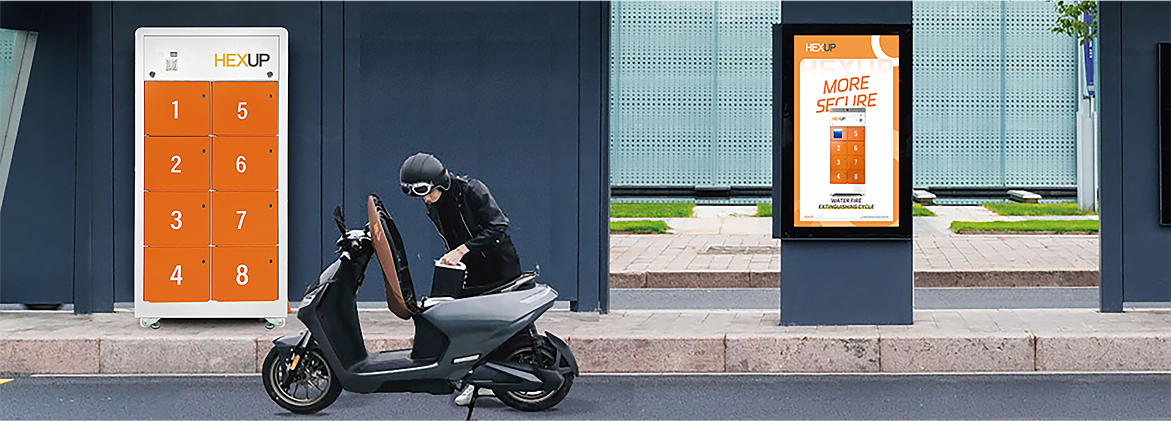 Whatsapp chat
Whatsapp chathexup.service@gmail.com
Why install a battery swap cabinet?
With the increasing global environmental awareness and the rapid development of the electric vehicle market, the adoption of electric two-wheelers in urban areas is increasing every year. Especially in industries such as food delivery and courier services, electric two-wheelers are favored due to their environmental friendliness, cost-effectiveness and convenience. However, a key challenge these vehicles face is the insufficient battery life and long charging time. Traditional charging methods are not only inefficient but also cause vehicles to be unable to travel during peak hours due to insufficient power, seriously affecting business continuity and service levels.
Battery swap cabinets address this isue by alowing users to replace batteries within minutes,significantly reducing vehicle downtime and improvingoperational ficiency. iditionaly,these cabinets provide a safe and standardized batteny management platlorm, avoidinethe safetyrisks associated with sel-chareineby user. forbusineses. the patteryswan madelreduces the cost at hattery nrocurement and maintenance, aleviating the nressure nticle hatteryinventory therebyenabling better resource utilization.

Which Markets Need Battery Swap Cabinets?
The demand for battery swap cabinets primarily comes from the following areas

Food Delivery and Courier Services

Urban Public Transportation

Policy Support
What Are the Revenue Models for Battery Swap Cabinets?
Battery swap cabinets have diverse revenue models, including
Pay-Per-Use
Subscription Service
Leasing and Sales Combination
Advertising and Value-Added Services
How to Choose the Specifications of Battery Swap Cabinets?
The specification of battery swap cabinets should be based on several key factors: usage scenarios, target user groups, installation environment, and expansion needs.
Usage Scenarios
Target User Groups
Installation Environment
Expansion Needs
View HEXUP battery swapping cabinet models
Examples and Comparisons of Operation Models
The choice of operation model directly determines the success of the battery swap cabinet project. Below are some common operation models and their comparative analysis:
Centralized Operation
Operators deploy battery swap cabinets in specific areas, such as commercial districts, office areas, or large residential areas. The advantage of this model is that it facilitates management and quickly achieves scale effects. The drawback is the high initial investment required, and it is susceptible to geographical limitations, making it difficult to cover dispersed user groups.
Distributed Operation
Battery swap cabinets are distributed across multiple locations, covering all corners of a city, especially transportation hubs and hotspot areas. This model is suitable for shared mobility or widely distributed business scenarios. The advantage lies in flexible deployment, meeting different user needs, and enhancing convenience. The downside is complex operational management and higher maintenance costs.
Hybrid Operation
Combining the advantages of centralized and distributed models, with high-capacity cabinets deployed in core areas and smaller stations in peripheral areas for full coverage operation. This model is suitable for large cities or multi-tier markets. Although the initial investment is significant, it can achieve higher operational efficiency through differentiated pricing and flexible dispatching.

Cooperative Operation
Collaborating with electric two-wheeler manufacturers, logistics companies, or government departments to jointly promote battery swap services. In this model, operators can share costs and profits with partners, achieving a win-win situation. This model is particularly suitable for regions with high entry barriers and intense market competition.
Independent Operation
Operators independently invest in and operate battery swap cabinets, fully controlling market pricing and service quality. While independent operation entails higher risks and responsibilities, if the market positioning is accurate and services are well-executed, it often results in high market share and profit margins.
The choice of operation model should consider local market demand, competitive environment, policy support, and the enterprise's resource capabilities. In practice, a pilot test can gradually optimize the operation model, ensuring the project's sustainable development. You can also contact HEXUP's marketing team for reasonable recommendations and planning.

Technical Challenges
Despite significant advancements in battery swap cabinet technology, several technical challenges remain in practical applications
Standardization Issues
Different brands and models of electric two-wheelers use varying battery specifications, requiring battery swap cabinets to be compatible with multiple battery types and interfaces. This diversity increases the complexity of cabinet design and manufacturing, presenting higher demands for future standardization.
Intelligent Management
Battery swap cabinets need real-time monitoring and data analysis capabilities to manage thousands of batteries and users. Intelligent management requires robust hardware support and reliable software systems, while also preventing data breaches and system failures. To achieve large-scale deployment and centralized management, cabinets must seamlessly integrate with cloud platforms and support remote maintenance and upgrades.

Safety and Stability
As energy storage devices, batteries' safety is critical. Battery swap cabinets must be equipped with multiple safety protection mechanisms, including temperature monitoring, overcharge protection, and leakage protection, to prevent safety incidents during battery swapping. Additionally, battery wear management and disposal are significant technical challenges, ensuring batteries do not pose risks to the environment and personnel at the end of their life.
Initial Investment and Maintenance Costs
High initial investment and ongoing maintenance costs are major obstacles to the promotion of battery swap cabinets. The hardware costs, software development, and operational maintenance of the cabinets all require significant capital investment. Controlling costs while ensuring equipment quality and user experience is a major challenge for suppliers and operators.
HEXUP can help you avoid risks with its extensive experience and R&D capabilities.

Safety and Customization
The safety of battery swap cabinets is not only central to product design but also crucial in building user trust. Here are key considerations for safety and customization:
Safety
Physical Safety
Cabinets should have waterproof, dustproof, and anti-theft physical protection to ensure normal operation in harsh environments.
Electrical Safety
Batteries can generate high temperatures and current fluctuations during charging and discharging. Cabinets need to be equipped with intelligent temperature control, overload protection, short
Data Security
Cabinets collect a large amount of user and equipment data during operation, and the security of this data is critical. Measures such as encrypted communication, access control, and data backup ensure that user privacy and operational data are not compromised or tampered with.

Customization

Appearance Customization
Depending on different brand needs, cabinets can offer custom appearance designs, including color, logos, and overall style, to enhance brand recognition.
Functionality Customization
To meet different market and business model needs, cabinet function modules can be flexibly customized. For example, supporting multi-language interfaces, integrating mobile payment functions, or adding advertising screens.
Software Customization
A dedicated software platform and applications can be developed according to specific client needs, enabling personalized device management, data analysis, and user interaction.
Choosing a Battery Swap Cabinet Manufacturer

Product Quality

Technical Support and Services
Product Compatibility

Pricing and Costs

Manufacturer Reputation and Experience

Innovation and Technology

Customization Capabilities

Certifications and standards
Considering these factors will help you choose the right battery swap cabinet manufacturer, ensuring smooth business operations.
If you still have more questions after understanding how to choose a battery swap cabinet, you can contact online support or check the FAQ on battery swap cabinet purchases.







